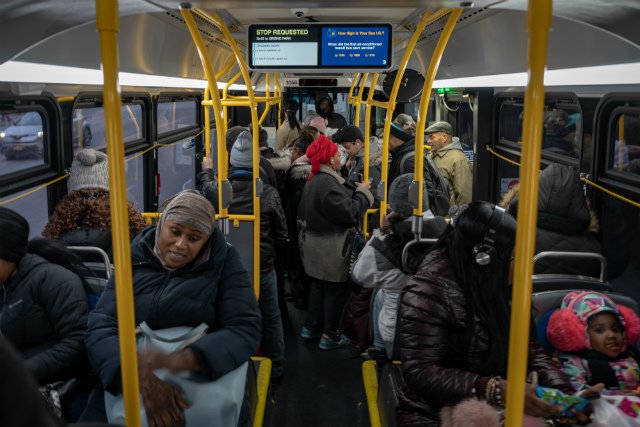Can The MTA Turn Around Notoriously Bad Bronx Bus Service? Andy Byford Has A Plan
June 14, 2019, 1:17 p.m.
Bus service in the Bronx remains some of the worst in New York, a titanic feat in a city where service overall is some of the slowest and most unreliable in the nation.

A crowded BX19 MTA bus en route to the Bronx's Botanical Gardens in January, 2019.
Bus service in the Bronx remains some of the worst in New York, a titanic feat in a city where service overall is some of the slowest and most unreliable in the nation.
With just a 6.5 mph average speed, bus speeds in the Bronx are slower than the citywide average, even though 16 percent of Bronxites commute to work by bus, second only to Staten Island, according to Transit Center’s Ashley Price. The poor service impacts New York's most vulnerable commuters, as bus riders are, on average, more likely to be people of color and have lower incomes than subway riders.
“Sometimes I walk faster than the bus,” weary Bx19 bus rider Ibn Mitchell told Gothamist earlier this year as the bus crawled tediously through the borough. Ridership on that route alone has fallen 16 percent since 2012, with ridership borough-wide falling 8.6 percent during the same time period.
Nevertheless, New York City Transit President Andy Byford projected optimism regarding his plan to redesign the Bronx bus network at an event on Thursday, citing successes in Staten Island and a doubling down on rider engagement efforts.
The event was hosted by Transit Center, one of the groups spearheading the “Bus Turnaround Campaign” to pressure the MTA and elected officials to improve the city’s woeful bus service. Sitting alongside Byford in the panel discussion included DOT’s Bronx Borough Commissioner Nivardo Lopez, Riders Alliance organizer Stephanie Burgos-Veras, and urban planner Christof Spieler.
The event was also held in the midst of a series of community meetings being hosted in the Bronx to gather input on NYCT’s draft network redesign from straphangers. The first open house took place on Tuesday, with another one on Wednesday and six more planned until June 27th.
Byford and others noted throughout the night that the narrative around his “Fast Forward” plan to improve the speed, reliability, and efficiency of the city’s transit network has often paid outsize attention to trains and ignored buses.
“I do try to get buses onto the transit committee agenda, but all anyone wants to talk about is subways,” Byford said. The $40 billion Fast Forward program encompasses not only fixing subways, but also using a variety of tools to improve bus service, from redesigning routes, to adding bus lanes, to even banning cars on certain busways such as 14th Street. Governor Andrew Cuomo, however, has balked at the estimated cost, and the ambitious plan is still not fully funded, despite the passage of congestion pricing in the recent state budget.
Burgos-Veras shared stories from riders that the Riders Alliance had recently collected from Bronx bus riders—detailing how poor service diminishes quality of life—such as that of Taylor, an express bus rider.
“‘I stood outside in a rainstorm for two hours just to get on an express bus in order to get to work,’” Burgos-Veras said, relaying Taylor’s story. “‘I have a lot of problems with the BxM7, so I left two hours early from my house to make sure I got to work on time. When the bus finally arrived, there was a lot of traffic, taking me even longer to get to work. This bus is so bad, I have almost gotten fired from my job, due to tardiness.’”
The plan, a draft of which was revealed earlier this year, would augment service on 31 bus lines in the Bronx, with tweaks ranging from eliminating duplicative or overly circuitous (in Byford’s words) service to the elimination of one line, the Bx38, and the creation of a new line in Manhattan called the M125 to replace the southern section of the Bx15.
Beyond just the redesign, the plan also includes measures to make the network more efficient, such as by adding more bus lanes protected or otherwise, expanding all-door boarding, and increasing the distance between stops, which are the most closely-bunched together among any major city, according to the MTA.
With the proposal to lengthen spaces between stops in particular, Byford told the audience that it would require “political courage” because you “can’t please everybody,” something he said that Staten Island Borough President Jimmy Oddo had acknowledged in the effort to improve service on the Staten Island Express Bus.
“Our average bus stop spacing here is 805 feet. That is way too close,” Byford said. “We should be aiming for 1300 feet, something like that, or possibly even a bit more.”
The Staten Island Express Bus, the first bus network which underwent a redesign under Byford’s Fast Forward plan, was redesigned to feature fewer stops in order to increase speed and frequency of service. Byford said on Thursday that commuters’ journey times are down and speeds are up since the redesign, though some commuters have complained of longer walks to stops and more overcrowding.
The success of the Staten Island redesign, in the MTA’s eyes, is being used as a model for the Bronx redesign, and further redesigns, including one that is beginning to take form in Queens. Byford referred to the redesigns as the “beginnings of a renaissance.”
Nonetheless, in an explicit nod to the challenges he’s faced with the city’s and state’s dysfunctional politics and its intersection with running the transit network, Byford said that political will must be built organically rather than enforced top-down.
“Every single step of the way, you’re fought to a stand,” Byford said. “If we carry forward like this, Fast Forward is dead in the water.”
We the Commuters is a weekly newsletter about transportation from WNYC and Gothamist. Sign up below for essential commuting coverage delivered to your inbox every Thursday.